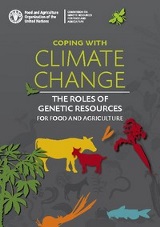Publications

Framework for Action on Biodiversity for Food and Agriculture
2022
The Framework for Action on Biodiversity for Food and Agriculture contains more than 50 individual actions grouped into three strategic priority areas: characterization, assessment and monitoring; management (sustainable use and conservation); and institutional frameworks.

The role of genetic resources for food and agriculture in adaptation to and mitigation of climate change
2022
The main focus of this study is the state of current use of genetic resources in climate change adaptation and mitigation efforts. Each chapter explores the impacts of climate change on genetic resources and also considers the significance of genetic resources to climate change adaptation and mitigation.

Council Resolution 1/168: The conservation and sustainable use of biodiversity for food and agriculture and the post-2020 global Biodiversity framework
2021
The Council endorsed the recommendations of the Report of the 18th Regular Session of the Commission, including the Framework for Action on Biodiversity for Food and Agriculture, and in particular adopted Council Resolution 1/168, The conservation and sustainable use of biodiversity for food and agriculture and the post-2020 global Biodiversity framework.

Biodiversity for Food and Agriculture – Frequently asked questions
2021
Based on information found in FAO’s report on The State of the World’s Biodiversity for Food and Agriculture published in 2019, this document provides simple answers to key questions about biodiversity for food and agriculture.

How the world's food security depends on biodiversity
2020
This brochure includes the contribution of genetic resources for food and agriculture to food security and to the achievement of relevant sustainable development goals.

ABS Elements Elements to Facilitate Domestic Implementation of Access and Benefit-Sharing for Different Subsectors of Genetic Resources for Food and Agriculture with Explanatory Notes
2019
This document contains the explanatory notes, as welcomed by the Commission and the FAO Conference in 2019, in shaded boxes to complement the ABS Elements.

The State of the World's Biodiversity for Food and Agriculture
2019
Prepared through a participatory, country-driven process, the report draws on information from 91 country reports to provide a description of the roles and importance of biodiversity for food and agriculture, the drivers of change affecting it and its current status and trends.

Proceedings of the International Workshop on Access and Benefit-Sharing for Genetic Resources for Food and Agriculture
2018
The International Workshop on Access and Benefit-Sharing for Genetic Resources for Food and Agriculture, addressed one of the key challenges policy-makers face in the development and implementation of access and benefit-sharing measures.

Voluntary Guidelines for Mainstreaming Biodiversity into Policies, Programmes and National and Regional Plans of Action on Nutrition
2016
The Guidelines aim to support countries in the development of nutrition-sensitive agriculture practices that consider the nutrient composition of biodiversity for food and agriculture to address malnutrition in all its forms.

Voluntary guidelines to support the integration of genetic diversity into national climate change adaptation planning
2015
The Guidelines address the genetic resources dimension of adaptation planning. They take into account the characteristics of different genetic resources for food and agriculture, which face different challenges and opportunities in respect to climate change.

Coping with Climate Change – The Roles of Genetic Resources for Food and Agriculture
2014
At the request of the Commission on Genetic Resources for Food and Agriculture, FAO prepared thematic studies on the interactions between climate change and plant, animal, forest, aquatic, invertebrate and micro-organism genetic resources. This publication summarizes the results of these studies.

